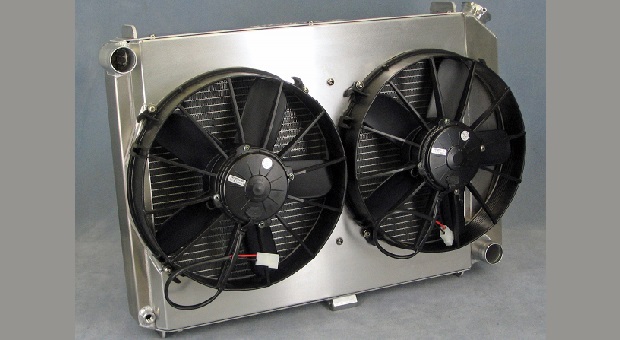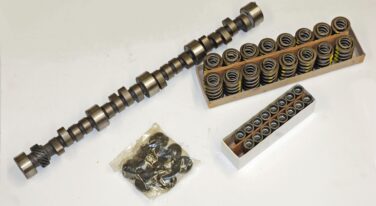
Why You Need a Fan Shroud
Click Here to Begin Slideshow
No one likes a car that overheats. That’s a no brainer. But when it comes to cooling you absolutely must first figure out a way to bring the air to the radiator (cooler). The idea is of course to provide a constant supply of air through the radiator so that the coolant is reduced in temperature. Increasing the airflow through the radiator improves the cooling and as a result, a shroud is almost mandatory on high performance applications. Unfortunately, they are often missing on any number of older cars. Keep in mind that shrouds are often manufactured from plastic and as result, the condition typically degrades dramatically over the years. If you don’t have a shroud or if it fits poorly, get the right one (that's a big hint if you end up sitting behind Old Faithful on a regular basis).
How does the shroud work? Basically, the shroud surrounds or partially surrounds the fan. It butts up tightly to the face of the radiator, effectively sealing the cavity. This isolates the pocket of air behind the radiator, allowing the fan to efficiently draw the required air through the radiator. If the shroud is not present, it creates a considerable amount of "dead" space behind the radiator that in turn destroys the effectiveness of the fan assembly. The bottom line is simple: If you don't run a proper shroud, you're only asking for overheating grief. So where do you find shrouds for older cars? That’s simple too: The restoration aftermarket is loaded with quality reproduction shrouds for all sorts of applications. They work.
That’s not the end of it though. In the case of electric fans, you usually have two options: A pusher fan and a puller fan. Motor vehicle manufacturers have used both configurations in modern passenger cars and light trucks, although puller fans are the most common. Sometimes electric fans are used in conjunction with an engine driven clutch fan (typically, an electric pusher fan mounted ahead of the rad). This arrangement is particularly useful if heavy cooling tasks are mandated by the application. A good example is a pickup truck with a factory towing package. This might be a good choice for a car that's either blessed with a cooling dilemma or one that sees double duty as a weekend racer.
Companies such as Ron Davis Racing Products have spent considerable time researching cooling fans with these criteria. Davis offers a trio of fans – 12-inch, 14-inch and 16-inch diameters. Specs are as follows:
Part Number Diameter RPM CFM
EF 120 12-inch 2300 1576
EF 140 14-inch 2400 1828
EF 160 16-inch 2400 2197
All of the above have a low amp draw, but Davis points out that one of the other secrets to properly cooling a high performance car is to effectively seal the radiator to the fan. Typically, this is accomplished by way of an integral shroud surrounding the electric fan. The shroud simply allows the largest volume of air to be pulled through the rad (typically in a pull through application). There’s more too: If you take the time to effectively seal any gaps between the fan shroud and the radiator, cooling can improve. It’s not that difficult to accomplish – see the accompanying photos for a closer look.
No one likes a car that overheats. That’s a no brainer. But when it comes to cooling you absolutely must first figure out a way to bring the air to the radiator (cooler). The idea is of course to provide a constant supply of air through the radiator so that the coolant is reduced in temperature. Increasing the airflow through the radiator improves the cooling and as a result, a shroud is almost mandatory on high performance applications. Unfortunately, they are often missing on any number of older cars. Keep in mind that shrouds are often manufactured from plastic and as result, the condition typically degrades dramatically over the years. If you don’t have a shroud or if it fits poorly, get the right one (that's a big hint if you end up sitting behind Old Faithful on a regular basis).
How does the shroud work? Basically, the shroud surrounds or partially surrounds the fan. It butts up tightly to the face of the radiator, effectively sealing the cavity. This isolates the pocket of air behind the radiator, allowing the fan to efficiently draw the required air through the radiator. If the shroud is not present, it creates a considerable amount of "dead" space behind the radiator that in turn destroys the effectiveness of the fan assembly. The bottom line is simple: If you don't run a proper shroud, you're only asking for overheating grief. So where do you find shrouds for older cars? That’s simple too: The restoration aftermarket is loaded with quality reproduction shrouds for all sorts of applications. They work.
That’s not the end of it though. In the case of electric fans, you usually have two options: A pusher fan and a puller fan. Motor vehicle manufacturers have used both configurations in modern passenger cars and light trucks, although puller fans are the most common. Sometimes electric fans are used in conjunction with an engine driven clutch fan (typically, an electric pusher fan mounted ahead of the rad). This arrangement is particularly useful if heavy cooling tasks are mandated by the application. A good example is a pickup truck with a factory towing package. This might be a good choice for a car that's either blessed with a cooling dilemma or one that sees double duty as a weekend racer.
Companies such as Ron Davis Racing Products have spent considerable time researching cooling fans with these criteria. Davis offers a trio of fans – 12-inch, 14-inch and 16-inch diameters. Specs are as follows:
Part Number Diameter RPM CFM
EF 120 12-inch 2300 1576
EF 140 14-inch 2400 1828
EF 160 16-inch 2400 2197
All of the above have a low amp draw, but Davis points out that one of the other secrets to properly cooling a high performance car is to effectively seal the radiator to the fan. Typically, this is accomplished by way of an integral shroud surrounding the electric fan. The shroud simply allows the largest volume of air to be pulled through the rad (typically in a pull through application). There’s more too: If you take the time to effectively seal any gaps between the fan shroud and the radiator, cooling can improve. It’s not that difficult to accomplish – see the accompanying photos for a closer look.



![[Gallery] Okolona Street Rods Kentuckiana V Foundation Car Show](https://www.racingjunk.com/news/wp-content/uploads/2022/04/IMG_0774-e1650040587750-376x206.jpg)
![[Gallery] Road Rats Car Show](https://www.racingjunk.com/news/wp-content/uploads/2022/05/2A-e1651770667920-376x206.jpg)

Leave a Reply